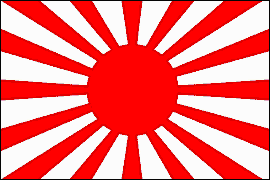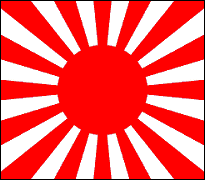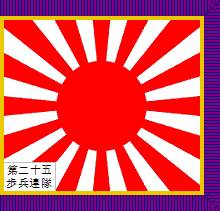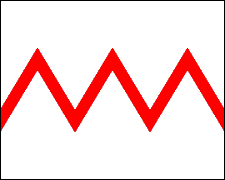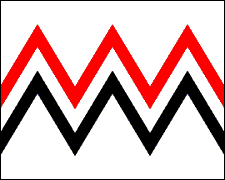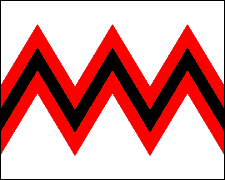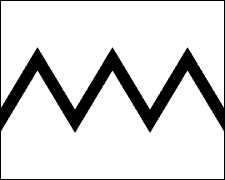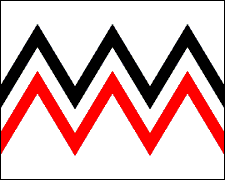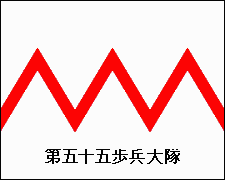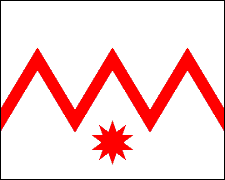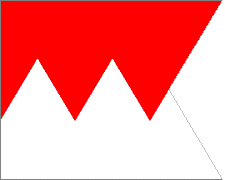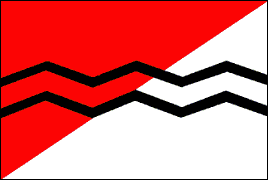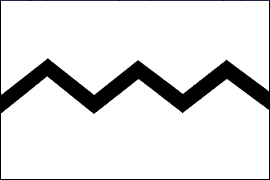|
|
|
EMPIRE OF JAPAN |
|
|
|
FLAGS OF
THE IMPERIAL JAPANESE ARMY • 1870s-1945 |
|
In the mid-nineteenth century Japan was still a feudal state under the Tokugawa Shogunate. But change was in the air and in 1868 the Meiji Restoration, spearheaded by a group of reformers, wrested political power from the Shogunate and vested it in the young Emperor Meiji. The reformers' aim was to end Japan's long-standing isolation from the outside world and transform the country into a modern state. A key component of this reform program was the creation of a true national army, trained and equipped along European lines. Under the Shogunate each feudal domain had maintained its own military forces that in theory could be called upon by the Shogun when needed. Several of these domain armies were amalgamated to form an "Imperial Army" during the civil war that overthrew the Shogunate but clearly more needed to be done. In 1871, therefore, the new government founded the Imperial Guard, initially 6,000 men strong. The Guard was organized with nine infantry battalions, four cavalry squadrons and two artillery batteries, and its mission was the protection of the imperial government against revolts and uprisings. A military ministry was created at the same time—later to be split into separate army and navy ministries—and in 1871 conscription was introduced. But progress was slow and by 1875 the Army's strength stood at just 33,000 men—this in a nation of 35 million. The Japanese relied on foreign military advisers to help them build a modern army. These were French at first but after that country's humiliating defeat in the Franco-Prussian War (1870-71) the practical Japanese switched to German advisers. The Imperial Army General Staff, created in 1878, was modeled on Germany's Great General Staff (Großgeneralstab). In 1882 the Imperial Receipt to Soldiers and Sailors codified the military ethos and formalized the intimate relationship between Emperor and Army. By the 1890s the Imperial Japanese Army was the most modern military force in Asia though by European standards it remained deficient in cavalry and artillery. But it was quite good enough to give the Chinese a drubbing in the First Sino-Japanese War (1894-95). The war ended China's dominion over Korea, which became an independent state, and established Japan as the dominant power in Asia. In 1904-05 the Imperial Japanese Army surprised the world by inflicting a series of humiliating defeats on Tsarist Russia in Manchuria. The Russo-Japanese War further enhanced the Army's prestige and political influence, setting the stage for decades of Japanese imperialist expansion in Asia and, ultimately, national disaster in World War II. The Imperial Japanese Army's fanaticism and savagery during World War II shocked its opponents. In outward form the Army was a modern military organization, but the ancient warrior ethos of the samurai lived on. The Japanese soldier was enjoined to fight to the death, never surrendering, and was taught to be contemptuous of enemies who dishonored themselves by surrender. In the Imperial Japanese Army fight to the death was no mere form of words: In battle after battle Japanese soldiers did just that. On Iwo Jima the defenders were almost completely wiped out; of 21,000 men, only 216 were taken prisoner. The rest perished, either in battle or by their own hand. In China and other conquered territories, prisoners of war and civilians were routinely subjected to wanton and often sadistic mistreatment. Japanese war crimes in China, Korea, the Philippines and elsewhere rivaled those of Germany in Russia, though they never received equivalent publicity.
With the
war clearly lost by 1945, the Imperial Japanese Army
prepared for a final fight to the death in the Japanese
Home Islands. But the atomic bomb ended the war on quite
different terms and despite the pleas of some fanatics
the Army obeyed the order of Emperor Hirohito to lay
down its arms. The unconditional surrender of Japan,
formalized, 2 September 1945 was the Imperial Japanese
Army's death warrant: Under Allied supervision it was
demobilized and dissolved. |
